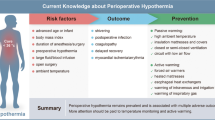Abstract
Rabbits were poisoned with carbon tetrachloride. After 12 hours, the body temperature of the animals was lowered and maintained at 31–32°C. for the next 12 hours by the surface-immersion technique. Liver function, as estimated by the time of appearence of BSP in bile, was found close to normal. This protective effect of hypothermia is probably due to the lowered basic metabolic rate.
Zusammenfassung
Kaninchen, die 12 Std nach Tetrachlorkohlenstoffvergiftung weitere 12 Std durch Oberflächen-Immersionstechnik bei 31–32°C unterkühlt wurden, zeigten bei der Zeitbestimmung des Ausscheidungsbeginns des Bromsulphophthaleins (BSP) in der Galle ein annähernd normales Verhalten der Leberfunktion. Die Schutzwirkung der Hypothermie beruht anscheinend auf der Herabsetzung des Stoffwechsels.
Similar content being viewed by others
Literatur
Bartsokas, St.: The effect of hypothermia, 31–32°C on carbon tetrachloride induced toxic hepatitis. Thesis, Athens Univ. 1969.
Blair, E.: Clinical hypothermia, p. 218–219. New York-Toronto-London: McGraw-Hill Book Co. 1964.
Blair, E., Hook, R., Tolley, H., Bunge, G. I.: Serum glutamic oxalacetic transaminase content in hypothermia. Science 133, 95–106 (1961).
Brauer, R.: Liver circulation and function. Physiol. Rev. 43, 115–213 (1963).
Brauer, R. W., Holloway, R. J., Krebs, J. S., Leong, G. F., Carrol, H. W.: The liver in hypothermia. Ann. N.Y. Acad. Sci. 80, 395–423 (1959).
Editorial: New Engl. J. Med. (1968).
Hardcastle, J. D., Ritchie, H. D.: The liver in shock. A comparison of some techniques, used currently in therapy. Brit. J. Surg. 55, 365–368 (1968).
Kanter, D. S.: Hypothermic hemoconcentration. Amer. J. Physiol. 214, 856–859 (1968).
Larson, R. A., Plaa, G. L.: A correlation of the effects of cervical cordotomy, hypothermia and catecholamines on carhon tetrachloride induced hepatic necrosis. J. Pharmacol. exp. Ther. 147, 103–11 (1965).
Montani, S., Perret, Cl.: Oxygénation hyperbare dans l'intoxication expérimentale au tétrachlorure de carbone. Rev. franç. Étud. clin. biol. 12, 274–278 (1967).
Preisig, R., Williams, R., Sweeting, J., Bradley, S.: Changes in sulfobromophthalein transport and storage by the liver during viral hepatitis in man. Amer. J. Med. 40, 170–183 (1966).
Schlicht, L.: Der Einfluß der Hypothermie auf die Leber bei experimenteller Tetrachlorkohlenstoffvergiftung. Klin. Wschr. 42, 806–812 (1964).
Author information
Authors and Affiliations
Rights and permissions
About this article
Cite this article
Bartsokas, S., Papadimitriou, D.G. & Varonos, D. Die Schutzwirkung der Hypothermie auf die Leberfunktion bei der Tetrachlorkohlenstoffvergiftung des Kaninchens. Arch Toxicol 29, 67–72 (1972). https://doi.org/10.1007/BF00316516
Received:
Issue Date:
DOI: https://doi.org/10.1007/BF00316516




